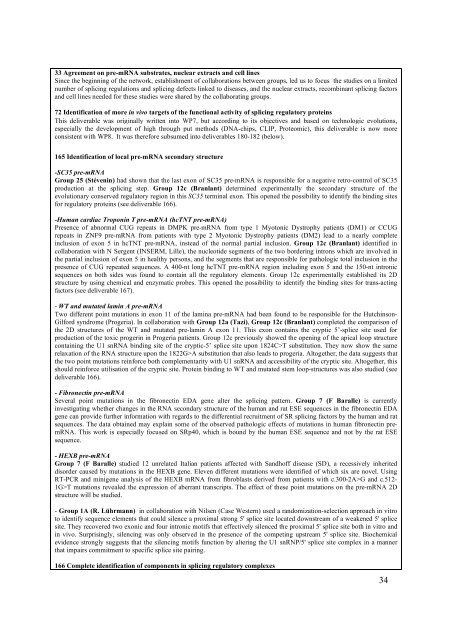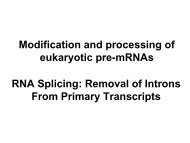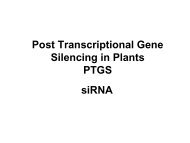You also want an ePaper? Increase the reach of your titles
YUMPU automatically turns print PDFs into web optimized ePapers that Google loves.
33 Agreement on pre-mRNA substrates, nuclear extracts and cell linesSince the beginning of the network, establishment of collaborations between groups, led us to focus the studies on a limitednumber of splicing regulations and splicing defects linked to diseases, and the nuclear extracts, recombinant splicing factorsand cell lines needed for these studies were shared by the collaborating groups.72 Identification of more in vivo targets of the functional activity of splicing regulatory proteinsThis deliverable was originally written into WP7, but according to its objectives and based on technologic evolutions,especially the development of high through put methods (DNA-chips, CLIP, Proteomic), this deliverable is now moreconsistent with WP8. It was therefore subsumed into deliverables 180-182 (below).165 Identification of local pre-mRNA secondary structure-SC35 pre-mRNAGroup 25 (Stévenin) had shown that the last exon of SC35 pre-mRNA is responsible for a negative retro-control of SC35production at the splicing step. Group 12c (Branlant) determined experimentally the secondary structure of theevolutionary conserved regulatory region in this SC35 terminal exon. This opened the possibility to identify the binding sitesfor regulatory proteins (see deliverable 166).-Human cardiac Troponin T pre-mRNA (hcTNT pre-mRNA)Presence of abnormal CUG repeats in DMPK pre-mRNA from type 1 Myotonic Dystrophy patients (DM1) or CCUGrepeats in ZNF9 pre-mRNA from patients with type 2 Myotonic Dystrophy patients (DM2) lead to a nearly completeinclusion of exon 5 in hcTNT pre-mRNA, instead of the normal partial inclusion. Group 12c (Branlant) identified incollaboration with N Sergent (INSERM, Lille), the nucleotide segments of the two bordering introns which are involved inthe partial inclusion of exon 5 in healthy persons, and the segments that are responsible for pathologic total inclusion in thepresence of CUG repeated sequences. A 400-nt long hcTNT pre-mRNA region including exon 5 and the 150-nt intronicsequences on both sides was found to contain all the regulatory elements. Group 12c experimentally established its 2Dstructure by using chemical and enzymatic probes. This opened the possibility to identify the binding sites for trans-actingfactors (see deliverable 167).- WT and mutated lamin A pre-mRNATwo different point mutations in exon 11 of the lamina pre-mRNA had been found to be responsible for the Hutchinson-Gilford syndrome (Progeria). In collaboration with Group 12a (Tazi), Group 12c (Branlant) completed the comparison ofthe 2D structures of the WT and mutated pre-lamin A exon 11. This exon contains the cryptic 5’-splice site used forproduction of the toxic progerin in Progeria patients. Group 12c previously showed the opening of the apical loop structurecontaining the U1 snRNA binding site of the cryptic-5’ splice site upon 1824C>T substitution. They now show the samerelaxation of the RNA structure upon the 1822G>A substitution that also leads to progeria. Altogether, the data suggests thatthe two point mutations reinforce both complementarity with U1 snRNA and accessibility of the cryptic site. Altogether, thisshould reinforce utilisation of the cryptic site. Protein binding to WT and mutated stem loop-structures was also studied (seedeliverable 166).- Fibronectin pre-mRNASeveral point mutations in the fibronectin EDA gene alter the splicing pattern. Group 7 (F Baralle) is currentlyinvestigating whether changes in the RNA secondary structure of the human and rat ESE sequences in the fibronectin EDAgene can provide further information with regards to the differential recruitment of SR splicing factors by the human and ratsequences. The data obtained may explain some of the observed pathologic effects of mutations in human fibronectin premRNA.This work is especially focused on SRp40, which is bound by the human ESE sequence and not by the rat ESEsequence.- HEXB pre-mRNAGroup 7 (F Baralle) studied 12 unrelated Italian patients affected with Sandhoff disease (SD), a recessively inheriteddisorder caused by mutations in the HEXB gene. Eleven different mutations were identified of which six are novel. UsingRT-PCR and minigene analysis of the HEXB mRNA from fibroblasts derived from patients with c.300-2A>G and c.512-1G>T mutations revealed the expression of aberrant transcripts. The effect of these point mutations on the pre-mRNA 2Dstructure will be studied.- Group 1A (R. Lührmann) in collaboration with Nilsen (Case Western) used a randomization-selection approach in vitroto identify sequence elements that could silence a proximal strong 5' splice site located downstream of a weakened 5' splicesite. They recovered two exonic and four intronic motifs that effectively silenced the proximal 5' splice site both in vitro andin vivo. Surprisingly, silencing was only observed in the presence of the competing upstream 5' splice site. Biochemicalevidence strongly suggests that the silencing motifs function by altering the U1 snRNP/5' splice site complex in a mannerthat impairs commitment to specific splice site pairing.166 Complete identification of components in splicing regulatory complexes34







